Dell EMC Technologies for Data Protection
Data security needs to be taken care of regardless of where they are located: in the cloud or in physical or virtual storage. Often, data are the company's most valuable asset, but their protection remains a weak link for many of them. According to IDC, up to 20% of backup operations do not fit into the allotted time, and 32% of data recovery attempts fail. Dell EMC technologies can reduce the backup window by up to 90% compared to traditional methods, reduce backup storage capacity requirements by up to 30 times, and network load almost doubled. These technologies provide fast recovery of both physical and virtual environments.
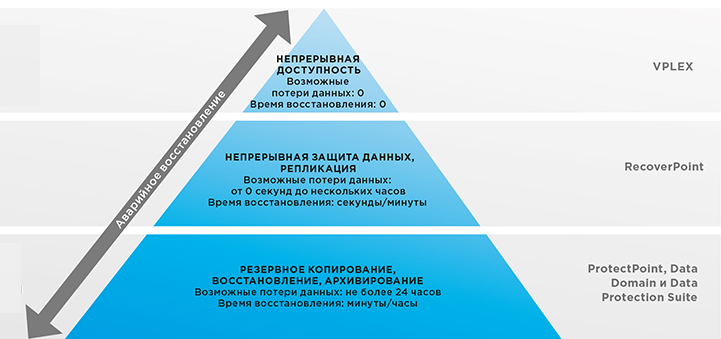
The Dell EMC data protection product line includes solutions for enterprises of all sizes. It doesn't matter where the data is stored and what happens in the processing center, Dell EMC offers the appropriate solution to protect it. At the core of this strategy are Dell EMC Data Domain technologies.
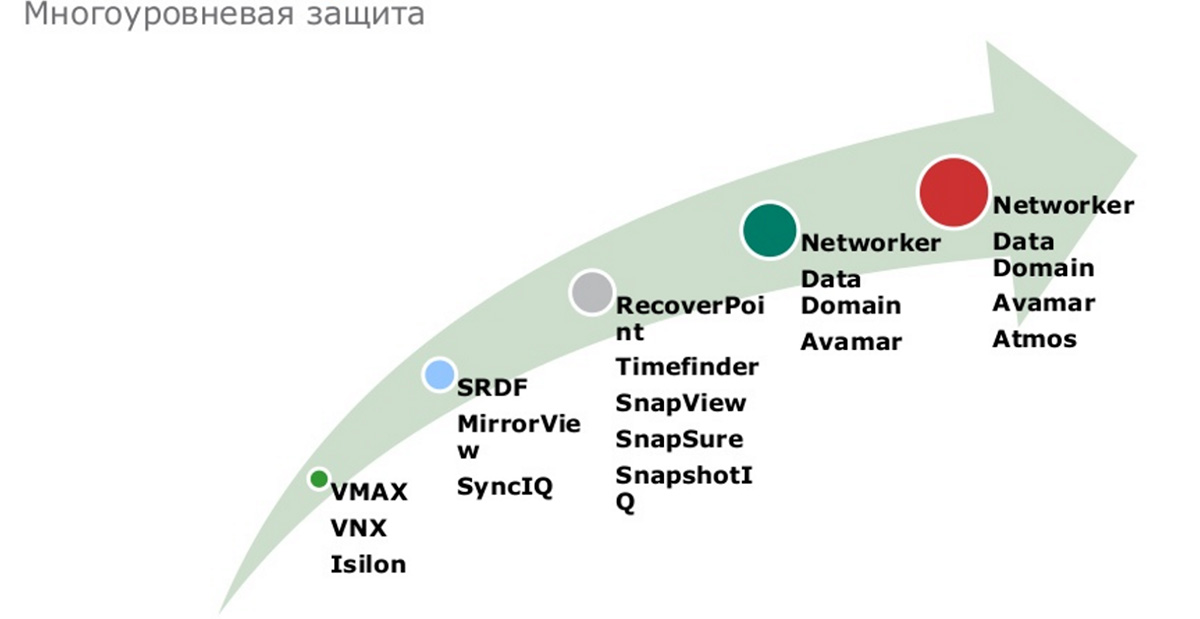
')
Data Domain technologies have become the foundation of the development of the Dell EMC Data Protection division. Data Domain was acquired by EMC in 2006, and this transaction enabled it to take a leading position in the data protection market.
The basic idea is to protect information everywhere, no matter where it is located - in the data center, in a virtual environment or in the cloud. In all cases, the Dell EMC can offer appropriate solutions, including support for continuous availability of the VPLEX, inter-array replication, data snapshot technology, RecoverPoint for continuous data protection, as well as software and hardware for backup and recovery, archiving, and building capabilities. backup as a service.
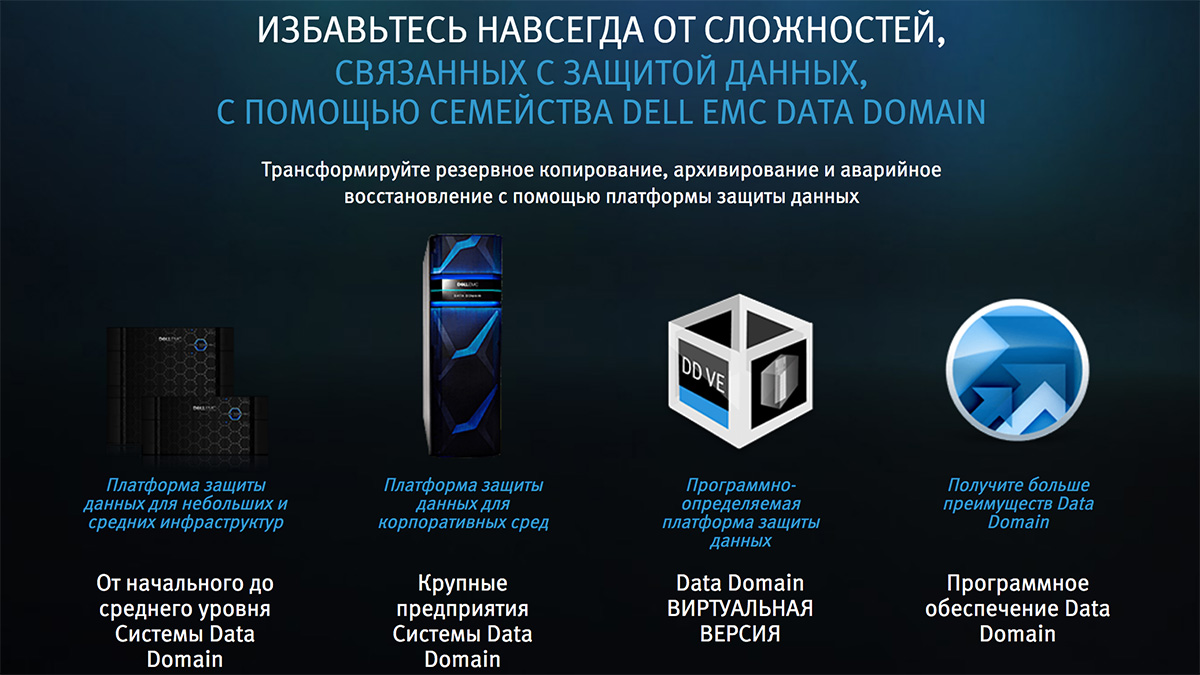
Data Domain owns 61% of the global data protection market. These technologies are used by more than 70,000 customers (including about 1,000 customers in Russia). They are used by 96% of large companies.
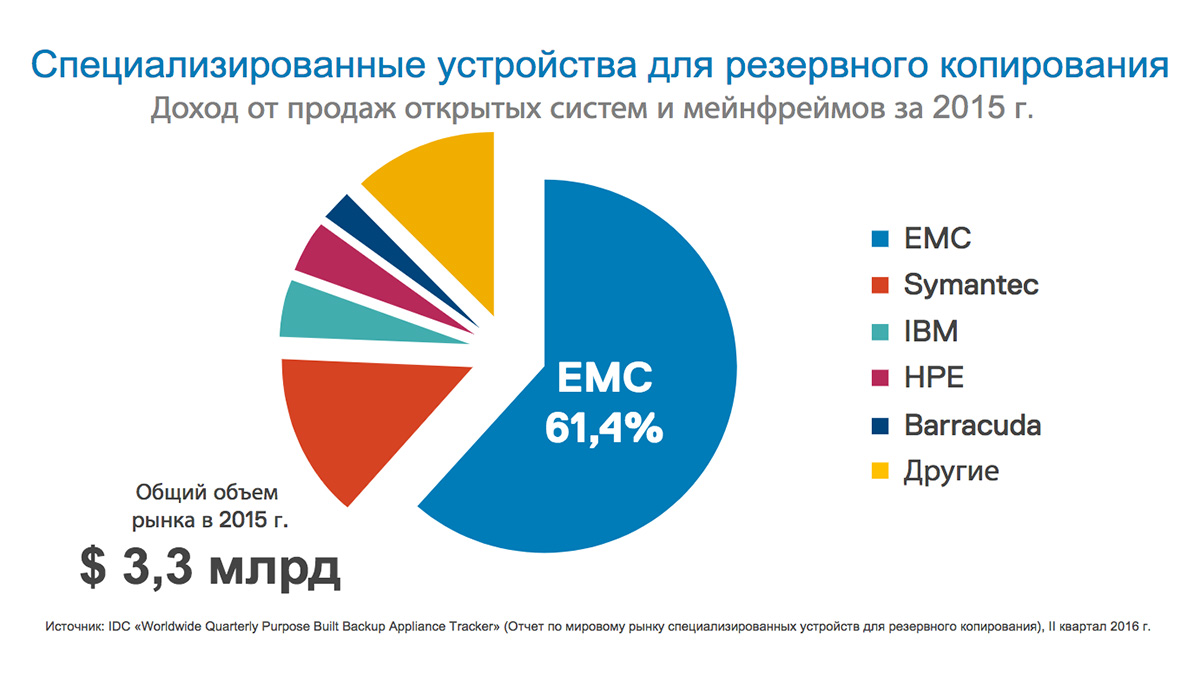
Data Domain is a high-performance and reliable x86-based system with an enterprise-class architecture. They use the component base of traditional storage solutions. All elements within the system are reserved, plus deduplication with variable block size is supported. According to statistics collected on the established systems, the average deduplication ratio is 12 to 1.
When using Data Domain products, the Dell EMC offers a wide range of use cases: traditional deployment of backup and disaster recovery systems; isolated recovery solutions; integrated solutions for data protection and converged infrastructures. Wherever the company stores the data, they will be fully protected.
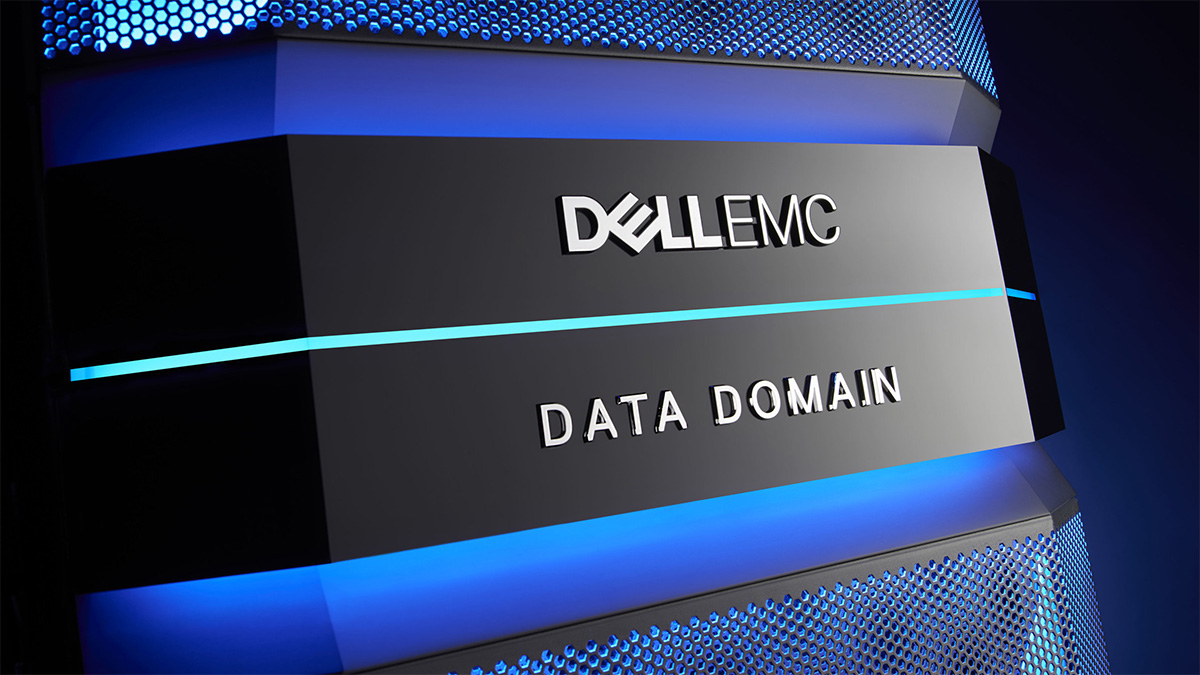
Isolated recovery technology is primarily aimed at protecting against external attacks, primarily related to data encryption. Even if the malware has encrypted or deleted workspace data, backups are preserved and information can be completely restored from Data Domain.
The Data Domain line includes several models of different classes with unified software. Single OS allows you to replicate data between systems. By replacing the head unit, you can switch to the next generation solution or the older model: this will simplify the operation of the system, extend its service life to 15 years and allow you to avoid data migration in the future.
There is also a virtual version of Data Domain that solves the problem of creating and storing backups in a fully virtual infrastructure.

Data Domain Virtual Edition (DD VE) data storage software was introduced last year. It is a virtual version of Data Domain with all its advantages in a software solution - simple, flexible, efficient and, most importantly, convenient to deploy and configure. Data Domain VE can be launched in just a few minutes. And the latest version of the program offers enhanced scalability and support for cloud services.
DD VE is primarily focused on enterprises with branches or using private or public clouds. You can deploy multiple instances in a virtual environment or remote offices for backup, and then replicate copies to a larger virtual or physical Data Domain system in the data center for disaster recovery. Thanks to the DD Replicator, which is part of DD VE, only unique data is transferred to the central Data Domain system, which reduces bandwidth requirements by up to 99%. In addition, you can plan the time of data transmission over the global network and limit the bandwidth using it for replication.
In addition to geographically distributed enterprises, DD VE can effectively protect the data of small companies or branches of larger businesses, as well as application data deployed in private or public clouds.
DD VE 3.0 supports Data Domain Cloud Tier, which allows clients to transfer data to the object storage in a public, private or hybrid cloud for long-term storage. Also, as in Data Domain, deduplication is supported: only unique data is sent directly from DD VE to Dell EMC Elastic Cloud Storage (ECS), Virtustream cloud storage or third-party providers such as Amazon / Azure, etc.

For long-term storage, data in the cloud is already deduplicated. This significantly reduces storage capacity and network bandwidth requirements, and also reduces total cost of ownership. In addition, DD VE supports multi-tenancy: the solution can be delivered as a service that allows you to logically isolate data between multiple tenants accessing a single instance of DD VE.
Software can also be deployed in converged infrastructure environments with support for the Dell EMC VxRail Appliance. DD VE provides additional security features for VxRail customers who want to increase backup efficiency, make it simple and flexible.

In addition to VMware, vSphere DD VE now supports Microsoft Hyper-V, in which you can deploy an instance of DD VE in just a few minutes. If we talk about scalability, the solution supports up to 96 TB of deduplicated data per copy. The DD VE licensing model provides flexible options for purchasing (in 1 TB increments) and deployment (one copy for each terabyte of backup data).
DD VE is certified to run on Dell EMC PowerEdge servers. This infrastructure will meet the necessary requirements for deploying backup software.
90% of the data in the world was generated in the last two years. Given the almost exponential growth of their volumes, enterprises understand the need to protect information. This requires solutions that reduce storage capacity requirements and eliminate redundant data. Data Domain uses deduplication technology: it identifies unique data in the input stream and stores only it.
To ensure efficient storage and protection, new Data Domain systems combine deduplication with variable-length blocks and enhanced scalability. The new high-performance Data Domain DD9800 system has a scalability parameter seven times higher than that of its closest competitor.
DD Cloud Tier allows you to expand the capacity of Data Domain three times due to the additional archival level. New Data Domain systems DD9800, DD9300 and DD6800 support this add-on for long-term cloud storage. They also provide high availability configurations: thanks to the second controller, which is in standby mode, medium and large corporate customers can achieve smooth operation. In case of equipment failure, the backup task switches to the second controller.

The new Dell EMC Data Domain systems provide higher performance than the previous generation - due to a number of new technologies, including SSDs for storing metadata. Thus, backup applications (for example, Dell EMC Avamar) can access virtual machines 20 times faster. The latest generation of technologies from Dell EMC also allows you to run up to 32 virtual machines directly from Data Domain.
Thanks to the Data Domain Boost protocol, only unique data is transmitted over an Ethernet or Fiber Channel network. This makes it possible to speed up the backup process several times and reduce the load on the channels by more than 90%. The database administrator can independently organize and control data backup and recovery, for example, to start DD Boost copying for any applications (including those for which there are no software agents).
Developed two years ago, Protect Point technology simplifies the protection infrastructure and eliminates unnecessary links in the data transfer chain during backup. In the traditional approach, the backup process involves several stages of data transfer, which increases its duration and can create bottlenecks. Often this approach requires a complex and expensive server infrastructure.
The EMC approach simplifies everything. For example, a VMAX array can be connected to the Data Domain system directly, which allows you to very quickly create a copy or restore data.
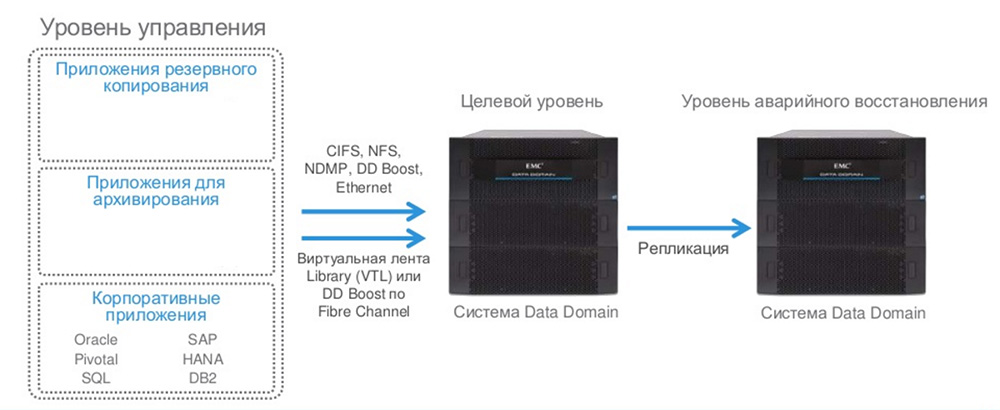
Virtual machines can be run directly from backups, while supporting instant start up to 32 units. With the help of granular recovery, you can quickly recover data from any applications, including mailboxes or user letters. The use of flash drives accelerated the recovery process up to 20 times, and the simple virtual environment was reduced to almost zero.
Companies are reviewing data protection methods. The exponential growth of information volumes, strict conditions of service level agreements, reduction of backup windows - all this makes it necessary to implement next-generation solutions. At the same time, each organization can have its own individual set of requirements. Based on this, the Dell EMC has developed the Data Protection Suite software packages, in five options: Data Protection Suite Enterprise Edition, Data Protection Suite for Backup, Data Protection Suite for VMware, Data Protection Suite for Applications, and Data Protection Suite for Archive.

Each package was created in response to business requirements and is designed for specific use cases in the most popular environments. At the same time, Dell EMC has simplified the choice of data protection, making it easier to apply solutions for replication, backup, recovery and archiving. Consider the unique advantages and capabilities of each of the five packages:
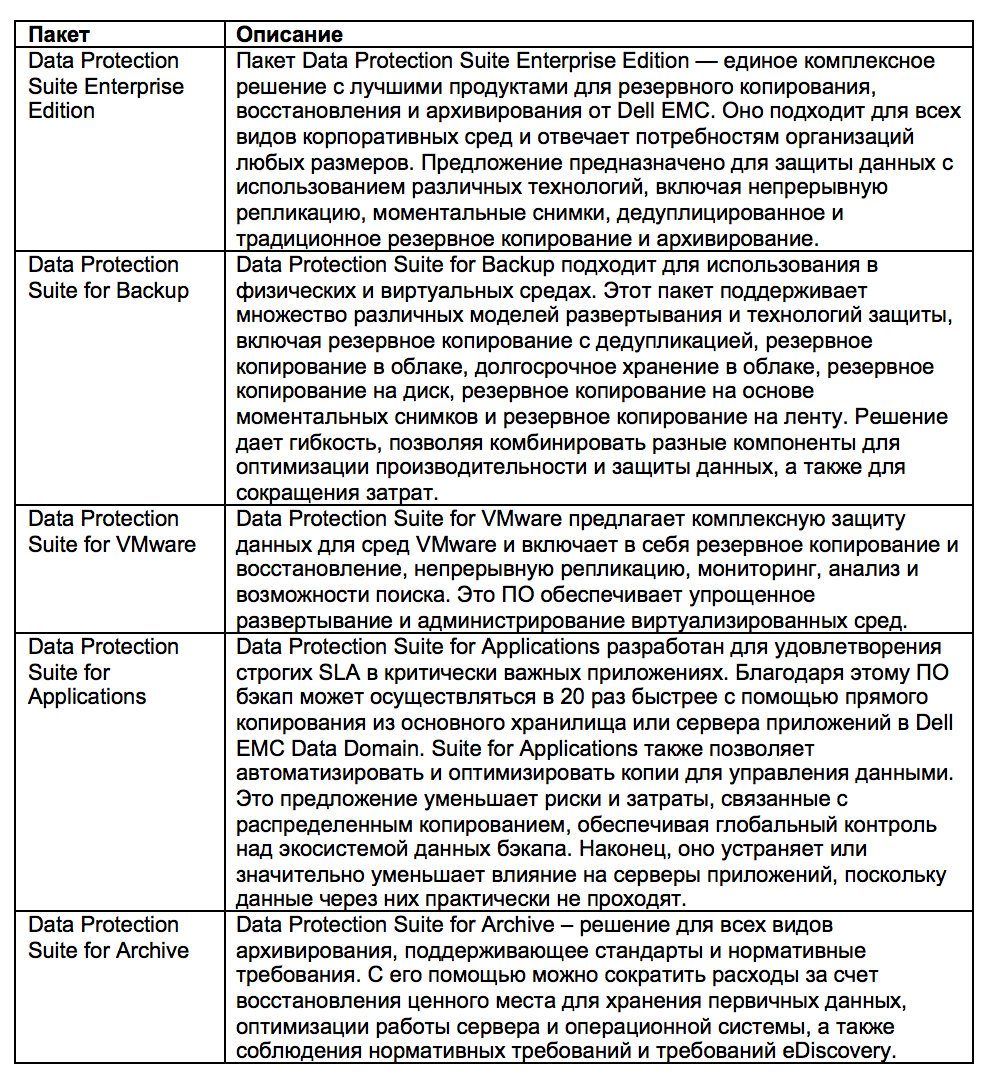
Data Protection Suite supports:
For backup of virtual environments, a compact virtual proxy is used. This approach allows an average of three times faster backup and recovery.
Version 9.2 also improves scalability. If earlier in one proxy up to 1000 virtual machines were supported, now it is 6 times more. Other parameters have also improved: the number of sessions, the number of simultaneously running virtual machines, etc. Deployment time was reduced, while performance increased by 2–3 times. This allows you to significantly reduce backup windows.
Data Protection Suite 9.2 now has the ability to transparently organize disaster recovery using virtual machine replication: any VM can be run in one or another data center.
Particular attention is paid to cloud support. You can use any cloud model: backup with transfer of information to a private or public cloud, data backup within the cloud, backup as a service — in a word, all directions that may be required in this case are supported.
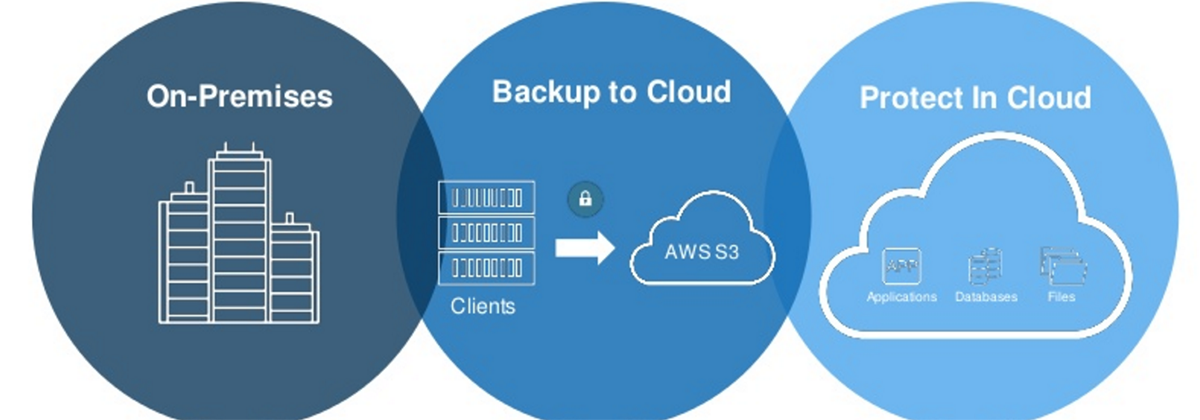
This year, a new specialized solution is presented, completely ready to work with the cloud. It helps to reduce the cost of organizing backup, provides support for convergent environments, pre-installed backup services and management software. Just plug it in, configure IP and clients.
In order to move some of the backup data to a public cloud service, such as Microsoft Azure or Amazon (AWS), Cloud Boost technology is provided. And Cloud Tier technology allows data to be transferred to lower-level storage — for example, to an external cloud with S3 protocol or EMC Elastic Cloud Storage. This will give the opportunity to store petabytes of archived data, reducing costs by almost three times.
Thanks to Networker, you can recover data from the archive level in just one step. All EMC products, including DD, Avamar and Networker, support the work in the cloud, which allows you to transparently transfer the entire infrastructure there.
With the release of Data Protection Suite, it became possible to create a large number of copies using Block Boost Backup technology, and Data Protection Adviser provides visualization and reporting system. The developers managed to significantly increase the level of data protection service and greatly simplify the backup process.

With the latest software update, using RecoverPoint has become much easier. This complex offers several options for protecting information: archival storage (when the data is in a single copy), backup, data snapshots, continuous protection (continuous replication), copying to the cloud.
The product solves the following main tasks:
Each method has its pros and cons. So, cloud backup allows you to save capacity, but recovery can take a lot of time. Snapshots of data and their storage on the same storage system will not help restore information in case of loss of the system.
There are security options for storing data on local and remote systems. In this case, RecoverPoint keeps a change log, and the administrator can configure RTO / RPO settings.
The program complex has the following main features:
The RecoverPoint line includes two versions. RecoverPoint 5.1 protects primarily the physical infrastructure and integrates with existing storage systems. RecoverPoint to protect virtual machines allows you to protect VMware virtual environments and integrates with the vCenter management system.
RecoverPoint allows you to quickly recover corporate services — for example, using data replication. You can recover data from a log and a copy that corresponds to a given point in time.
RecoverPoint developers are trying to make this process as simple as possible. To configure synchronous or asynchronous replication, the administrator selects a log, a destination, indicates where a copy of the data and a copy of the log will be stored. Then the system does everything itself. In a virtual environment, a special plug-in for vSphere allows you to implement fairly complex data protection mechanisms. It also helps to perform the recovery of the virtual machine at the right moment.
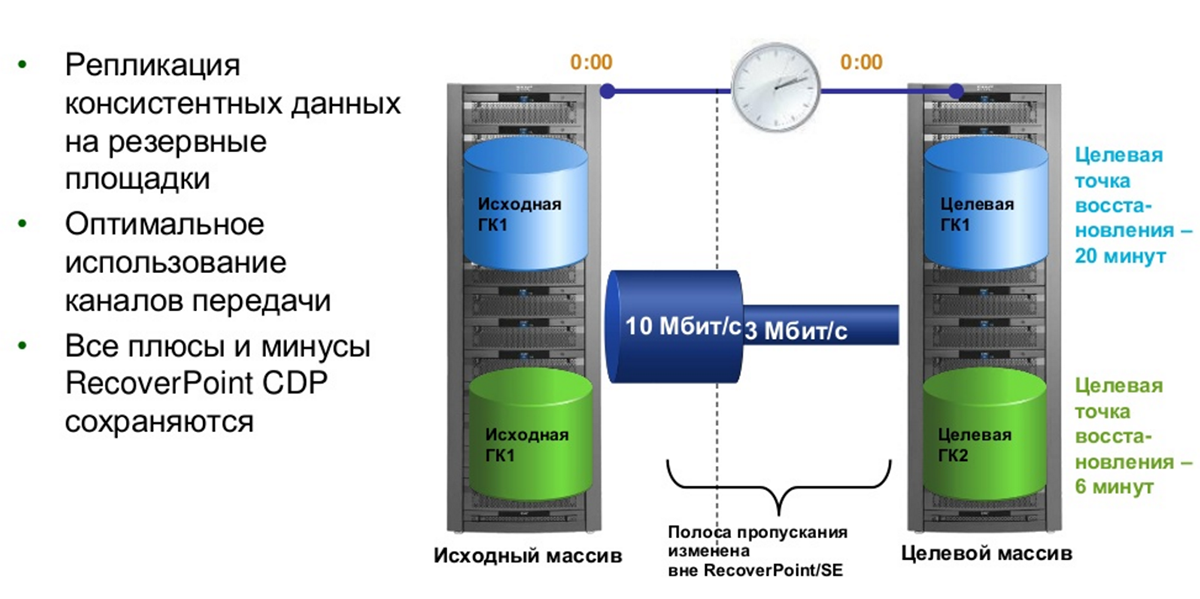
Thus, data protection becomes as simple as possible. The administrator selects the volume, selects the remote array, and allocates resources on the remote system, and RecoverPoint automatically starts replication (for example, between VMAX and ScaleIO systems).
The software now supports new ScaleIO arrays and Snapshot Replication functions using its own VMAX and ScaleIO storage systems, which improves performance. The interval between data snapshots is 1 minute. Replication can be synchronous or asynchronous.
The RecoverPoint Appliance monitors all changes in the data after the initial synchronization, computes the “delta” between the two snapshots and replicates it to the remote array. Information can be replicated from the VMAX system to a simpler array on the backup site.
RecoverPoint for VM is a virtual machine integrated with vCenter. This is a rather complicated product, but its installation is simplified. Data is replicated between two VMs at different sites, and you can also assemble a High Availability Cluster (HA). The new management console provides monitoring of system status and SLA control.
How to recover a large number of virtual machines? This must be done by priorities, in groups, otherwise the storage resources will be quickly exhausted. VM templates can be assigned an SLA - specified RPO, specify the type of replication.
The reality is that traditional backup systems do not allow recovering data after serious failures while adhering to the accepted SLA. Dell EMC does not offer a single boxed solution that would allow it, but it provides the widest range of backup and data recovery tools. Solutions such as Data Domain, VPLEX, RecoverPoint, and various disk array technologies are often used in many different projects. With their help, you can build a really working data protection system that will not fail in a critical situation.

The Dell EMC data protection product line includes solutions for enterprises of all sizes. It doesn't matter where the data is stored and what happens in the processing center, Dell EMC offers the appropriate solution to protect it. At the core of this strategy are Dell EMC Data Domain technologies.

')
Data Domain
Data Domain technologies have become the foundation of the development of the Dell EMC Data Protection division. Data Domain was acquired by EMC in 2006, and this transaction enabled it to take a leading position in the data protection market.
The basic idea is to protect information everywhere, no matter where it is located - in the data center, in a virtual environment or in the cloud. In all cases, the Dell EMC can offer appropriate solutions, including support for continuous availability of the VPLEX, inter-array replication, data snapshot technology, RecoverPoint for continuous data protection, as well as software and hardware for backup and recovery, archiving, and building capabilities. backup as a service.

Data Domain owns 61% of the global data protection market. These technologies are used by more than 70,000 customers (including about 1,000 customers in Russia). They are used by 96% of large companies.

Data Domain is a high-performance and reliable x86-based system with an enterprise-class architecture. They use the component base of traditional storage solutions. All elements within the system are reserved, plus deduplication with variable block size is supported. According to statistics collected on the established systems, the average deduplication ratio is 12 to 1.
When using Data Domain products, the Dell EMC offers a wide range of use cases: traditional deployment of backup and disaster recovery systems; isolated recovery solutions; integrated solutions for data protection and converged infrastructures. Wherever the company stores the data, they will be fully protected.

Isolated recovery technology is primarily aimed at protecting against external attacks, primarily related to data encryption. Even if the malware has encrypted or deleted workspace data, backups are preserved and information can be completely restored from Data Domain.
The Data Domain line includes several models of different classes with unified software. Single OS allows you to replicate data between systems. By replacing the head unit, you can switch to the next generation solution or the older model: this will simplify the operation of the system, extend its service life to 15 years and allow you to avoid data migration in the future.
There is also a virtual version of Data Domain that solves the problem of creating and storing backups in a fully virtual infrastructure.

Data Domain Virtual Edition
Data Domain Virtual Edition (DD VE) data storage software was introduced last year. It is a virtual version of Data Domain with all its advantages in a software solution - simple, flexible, efficient and, most importantly, convenient to deploy and configure. Data Domain VE can be launched in just a few minutes. And the latest version of the program offers enhanced scalability and support for cloud services.
DD VE is primarily focused on enterprises with branches or using private or public clouds. You can deploy multiple instances in a virtual environment or remote offices for backup, and then replicate copies to a larger virtual or physical Data Domain system in the data center for disaster recovery. Thanks to the DD Replicator, which is part of DD VE, only unique data is transferred to the central Data Domain system, which reduces bandwidth requirements by up to 99%. In addition, you can plan the time of data transmission over the global network and limit the bandwidth using it for replication.
In addition to geographically distributed enterprises, DD VE can effectively protect the data of small companies or branches of larger businesses, as well as application data deployed in private or public clouds.
DD VE 3.0 supports Data Domain Cloud Tier, which allows clients to transfer data to the object storage in a public, private or hybrid cloud for long-term storage. Also, as in Data Domain, deduplication is supported: only unique data is sent directly from DD VE to Dell EMC Elastic Cloud Storage (ECS), Virtustream cloud storage or third-party providers such as Amazon / Azure, etc.

For long-term storage, data in the cloud is already deduplicated. This significantly reduces storage capacity and network bandwidth requirements, and also reduces total cost of ownership. In addition, DD VE supports multi-tenancy: the solution can be delivered as a service that allows you to logically isolate data between multiple tenants accessing a single instance of DD VE.
Software can also be deployed in converged infrastructure environments with support for the Dell EMC VxRail Appliance. DD VE provides additional security features for VxRail customers who want to increase backup efficiency, make it simple and flexible.

In addition to VMware, vSphere DD VE now supports Microsoft Hyper-V, in which you can deploy an instance of DD VE in just a few minutes. If we talk about scalability, the solution supports up to 96 TB of deduplicated data per copy. The DD VE licensing model provides flexible options for purchasing (in 1 TB increments) and deployment (one copy for each terabyte of backup data).
DD VE is certified to run on Dell EMC PowerEdge servers. This infrastructure will meet the necessary requirements for deploying backup software.
Faster, easier, safer
90% of the data in the world was generated in the last two years. Given the almost exponential growth of their volumes, enterprises understand the need to protect information. This requires solutions that reduce storage capacity requirements and eliminate redundant data. Data Domain uses deduplication technology: it identifies unique data in the input stream and stores only it.
To ensure efficient storage and protection, new Data Domain systems combine deduplication with variable-length blocks and enhanced scalability. The new high-performance Data Domain DD9800 system has a scalability parameter seven times higher than that of its closest competitor.
DD Cloud Tier allows you to expand the capacity of Data Domain three times due to the additional archival level. New Data Domain systems DD9800, DD9300 and DD6800 support this add-on for long-term cloud storage. They also provide high availability configurations: thanks to the second controller, which is in standby mode, medium and large corporate customers can achieve smooth operation. In case of equipment failure, the backup task switches to the second controller.

The new Dell EMC Data Domain systems provide higher performance than the previous generation - due to a number of new technologies, including SSDs for storing metadata. Thus, backup applications (for example, Dell EMC Avamar) can access virtual machines 20 times faster. The latest generation of technologies from Dell EMC also allows you to run up to 32 virtual machines directly from Data Domain.
Thanks to the Data Domain Boost protocol, only unique data is transmitted over an Ethernet or Fiber Channel network. This makes it possible to speed up the backup process several times and reduce the load on the channels by more than 90%. The database administrator can independently organize and control data backup and recovery, for example, to start DD Boost copying for any applications (including those for which there are no software agents).
Developed two years ago, Protect Point technology simplifies the protection infrastructure and eliminates unnecessary links in the data transfer chain during backup. In the traditional approach, the backup process involves several stages of data transfer, which increases its duration and can create bottlenecks. Often this approach requires a complex and expensive server infrastructure.
The EMC approach simplifies everything. For example, a VMAX array can be connected to the Data Domain system directly, which allows you to very quickly create a copy or restore data.

Virtual machines can be run directly from backups, while supporting instant start up to 32 units. With the help of granular recovery, you can quickly recover data from any applications, including mailboxes or user letters. The use of flash drives accelerated the recovery process up to 20 times, and the simple virtual environment was reduced to almost zero.
Data Protection Suite
Companies are reviewing data protection methods. The exponential growth of information volumes, strict conditions of service level agreements, reduction of backup windows - all this makes it necessary to implement next-generation solutions. At the same time, each organization can have its own individual set of requirements. Based on this, the Dell EMC has developed the Data Protection Suite software packages, in five options: Data Protection Suite Enterprise Edition, Data Protection Suite for Backup, Data Protection Suite for VMware, Data Protection Suite for Applications, and Data Protection Suite for Archive.

Each package was created in response to business requirements and is designed for specific use cases in the most popular environments. At the same time, Dell EMC has simplified the choice of data protection, making it easier to apply solutions for replication, backup, recovery and archiving. Consider the unique advantages and capabilities of each of the five packages:

Data Protection Suite supports:
- backup without media server,
- block and granular backups for most major enterprise applications,
- CBT when copying virtual environments
- cloud backup
- dynamic policies, etc.
For backup of virtual environments, a compact virtual proxy is used. This approach allows an average of three times faster backup and recovery.
Version 9.2 also improves scalability. If earlier in one proxy up to 1000 virtual machines were supported, now it is 6 times more. Other parameters have also improved: the number of sessions, the number of simultaneously running virtual machines, etc. Deployment time was reduced, while performance increased by 2–3 times. This allows you to significantly reduce backup windows.
Data Protection Suite 9.2 now has the ability to transparently organize disaster recovery using virtual machine replication: any VM can be run in one or another data center.
Particular attention is paid to cloud support. You can use any cloud model: backup with transfer of information to a private or public cloud, data backup within the cloud, backup as a service — in a word, all directions that may be required in this case are supported.

This year, a new specialized solution is presented, completely ready to work with the cloud. It helps to reduce the cost of organizing backup, provides support for convergent environments, pre-installed backup services and management software. Just plug it in, configure IP and clients.
In order to move some of the backup data to a public cloud service, such as Microsoft Azure or Amazon (AWS), Cloud Boost technology is provided. And Cloud Tier technology allows data to be transferred to lower-level storage — for example, to an external cloud with S3 protocol or EMC Elastic Cloud Storage. This will give the opportunity to store petabytes of archived data, reducing costs by almost three times.
Thanks to Networker, you can recover data from the archive level in just one step. All EMC products, including DD, Avamar and Networker, support the work in the cloud, which allows you to transparently transfer the entire infrastructure there.
With the release of Data Protection Suite, it became possible to create a large number of copies using Block Boost Backup technology, and Data Protection Adviser provides visualization and reporting system. The developers managed to significantly increase the level of data protection service and greatly simplify the backup process.

RecoverPoint: Protect critical data with recovery at any time
With the latest software update, using RecoverPoint has become much easier. This complex offers several options for protecting information: archival storage (when the data is in a single copy), backup, data snapshots, continuous protection (continuous replication), copying to the cloud.
The product solves the following main tasks:
- real-time data protection
- data recovery at any time
- hardware independent replication.
Each method has its pros and cons. So, cloud backup allows you to save capacity, but recovery can take a lot of time. Snapshots of data and their storage on the same storage system will not help restore information in case of loss of the system.
There are security options for storing data on local and remote systems. In this case, RecoverPoint keeps a change log, and the administrator can configure RTO / RPO settings.
The program complex has the following main features:
- recovery at any time
- instant recovery,
- integration with applications
- replication of consistent data to backup sites
- ability to restore to other servers
- optimal use of transmission channels
- hardware independence
The RecoverPoint line includes two versions. RecoverPoint 5.1 protects primarily the physical infrastructure and integrates with existing storage systems. RecoverPoint to protect virtual machines allows you to protect VMware virtual environments and integrates with the vCenter management system.
RecoverPoint allows you to quickly recover corporate services — for example, using data replication. You can recover data from a log and a copy that corresponds to a given point in time.
RecoverPoint developers are trying to make this process as simple as possible. To configure synchronous or asynchronous replication, the administrator selects a log, a destination, indicates where a copy of the data and a copy of the log will be stored. Then the system does everything itself. In a virtual environment, a special plug-in for vSphere allows you to implement fairly complex data protection mechanisms. It also helps to perform the recovery of the virtual machine at the right moment.

Thus, data protection becomes as simple as possible. The administrator selects the volume, selects the remote array, and allocates resources on the remote system, and RecoverPoint automatically starts replication (for example, between VMAX and ScaleIO systems).
The software now supports new ScaleIO arrays and Snapshot Replication functions using its own VMAX and ScaleIO storage systems, which improves performance. The interval between data snapshots is 1 minute. Replication can be synchronous or asynchronous.
The RecoverPoint Appliance monitors all changes in the data after the initial synchronization, computes the “delta” between the two snapshots and replicates it to the remote array. Information can be replicated from the VMAX system to a simpler array on the backup site.
RecoverPoint for VM is a virtual machine integrated with vCenter. This is a rather complicated product, but its installation is simplified. Data is replicated between two VMs at different sites, and you can also assemble a High Availability Cluster (HA). The new management console provides monitoring of system status and SLA control.
How to recover a large number of virtual machines? This must be done by priorities, in groups, otherwise the storage resources will be quickly exhausted. VM templates can be assigned an SLA - specified RPO, specify the type of replication.
Summary
The reality is that traditional backup systems do not allow recovering data after serious failures while adhering to the accepted SLA. Dell EMC does not offer a single boxed solution that would allow it, but it provides the widest range of backup and data recovery tools. Solutions such as Data Domain, VPLEX, RecoverPoint, and various disk array technologies are often used in many different projects. With their help, you can build a really working data protection system that will not fail in a critical situation.
Source: https://habr.com/ru/post/345632/
All Articles